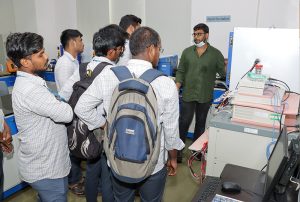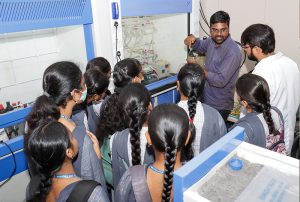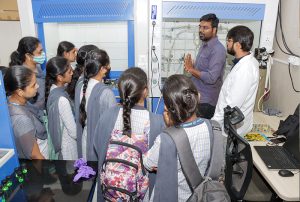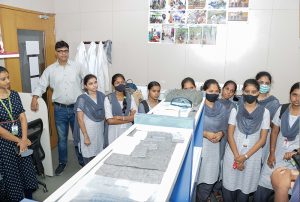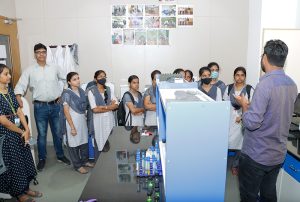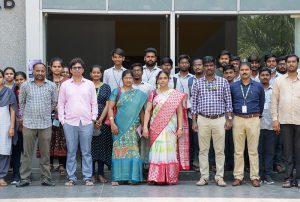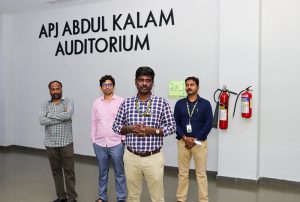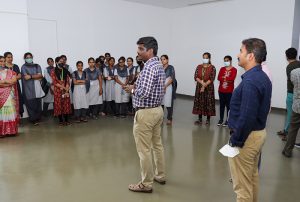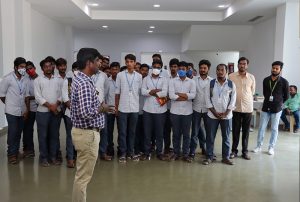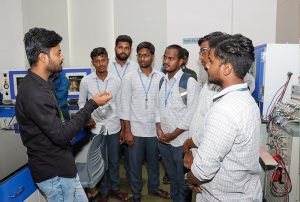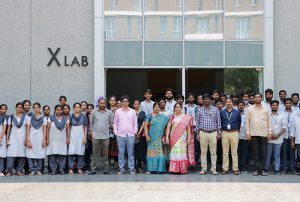All Management Events
- One-stop solution to green urea synthesis May 12, 2022

Prof Ranjit Thapa and his PhD scholar, Mr Samadhan Kapse from the Department of Physics have reported their euphoric achievement of discovering an economically viable electrocatalyst for effective green urea synthesis. The paper “Selective Electrocatalytic Co-reduction of N2 and CO2 on Copper Phthalocyanine for Green Urea Production” has been published in the highly prestigious Nature indexed journal, ‘Advanced Functional Materials’, having an Impact Factor of 18.81. It was published in collaboration with Jit Mukherjee, and Uttam Kumar Ghorai, from the Department of Industrial Chemistry & Applied Chemistry, Swami Vivekananda Research Centre.
With global annual production of 100 million tons, urea is one of the important nitrogen sources for the fertilizer industry. Industrial urea is synthesized by the following two consecutive steps. First, the reaction of nitrogen and hydrogen (N2 + H2 → NH3) by the Haber-Bosch process at high temperature and pressure (350–550°C, 150–350 bar); followed by the reaction of NH3 and CO2 [NH3 + CO2 → CO(NH2)2] under mild reaction conditions (170–200°C and 200–250 bar). The sequential reactions are carried out for several cycles to increase the conversion efficiency. For the first step, fixation of N2 is an energy as well as a capital intensive process due to difficulty in cleaving the N≡N bond. Extensive research works have been reported on electrochemical N2 fixation to NH3 in water medium under ambient conditions. In this electrochemical method, isolation of NH3 gas with high purity from electrolyte solution is troublesome. In the second step, CO2 fixation on the substrate and its separation is one of the major challenging tasks for the further reaction with NH3 to end up in urea formation. Overall, the two-step process for large scale production of urea consumes high energy and produces greenhouse gases for the environment.
The research team reported copper-phthalocyanine nanotubes (CuPc NTs) having multiple active sites as an efficient electrocatalyst which exhibits a tremendous yield of urea with good durability and long-term stability. DFT calculation predicts that Pyridinic–N1 in CuPc is responsible for N2 reduction and the metal centre plays an important role for CO2 reduction. This study not only provides us with the co-reduction of N2 and CO2 gases using cost-effective CuPc NTs catalyst but also opens a new pathway to the rational design of other transitional metal-based electrocatalysts having multiple active sites for N2 and CO2 gas fixation applications.
This electrochemical method of urea synthesis by the co-reduction of N2 and CO2 [N2 + CO2 + 6H+ + 6e– → CO(NH2)2 + H2O] using an efficient electrocatalyst in a water medium under ambient conditions would be an alternative way in the upcoming days. All the strategies using alloys and heterostructure for urea synthesis forming C–N bond by the co–reduction of N2 and CO2 have not reached the benchmark in terms of urea yield rate and FE for practical applications. To achieve a high urea yield and FE, various factors are to be considered in this work.
Abstract of the Research
Green synthesis of urea under ambient conditions by electrochemical co-reduction of N2 and CO2 gases using effective electrocatalyst essentially pushes the conventional two steps (N2 + H2 = NH3 & NH3 + CO2 = CO (NH2)2) industrial process at high temperature and high pressure, to the brink. The single-step electrochemical green urea synthesis process has hit a roadblock due to the lack of an efficient and economically viable electrocatalyst with multiple active sites for dual reduction of N2 and CO2 gas molecules to urea. Herein, the research reports copper-phthalocyanine nanotubes (CuPc NTs) having multiple active sites (such as metal centre, Pyrrolic-N3, Pyrrolic-N2, and Pyridinic-N1) as an efficient electrocatalyst which exhibits urea yield of 143.47 µg h-1 mg-1cat and FE of 12.99% at –0.6 V vs RHE by co-reduction of N2 and CO2. Theoretical calculation suggests that Pyridinic-N1 and Cu centres are responsible to form C–N bonds for urea by co-reduction of N2 to NN* and CO2 to *CO respectively. This study provides new mechanistic insight into the successful electro-reduction of dual gases (N2 and CO2) in a single molecule as well as the rational design of an efficient noble metal-free electrocatalyst for the synthesis of green urea.
Continue reading → - In conversation with Prof B S Murty, Director, IIT Hyderabad May 11, 2022
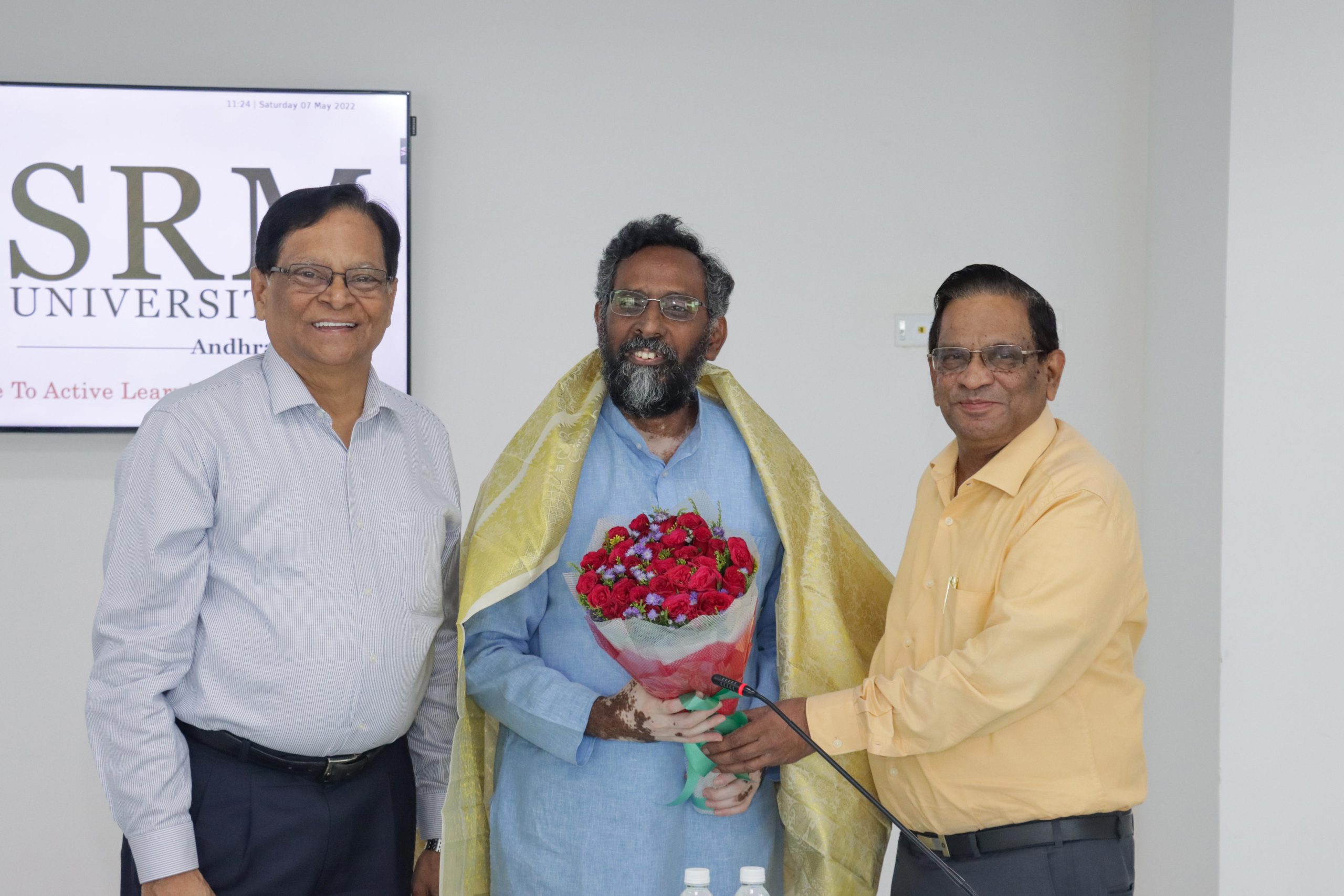
SRM University-AP organised an interactive session with Prof B S Murty, Director, IIT Hyderabad, on May 7, 2022, to enhance the research collaborations and capabilities of the institution. Honourable Vice-Chancellor, Prof V S Rao; Pro Vice-Chancellor, Prof D Narayana Rao, all the faculty members, and research scholars took part in the conference.
The meeting deliberated on the need to develop platforms for effective research collaborations across multiple disciplines to maintain successful research careers. It accentuated on the necessity of bringing together inter-disciplinary resources, culture, talent, and scientific knowledge to enhance the depth and breadth of research capabilities. Building intensive research networks and making relevant contributions towards the inclusive development of the society were the major focus points of the discussion.
Prof V S Rao welcomed the gathering and introduced the guest of the day, Prof B S Murty. He reminisced over the long association with Prof Murty, the much renowned Indian metallurgist who has been recognised with the highest science award in the country.
Prof B S Murty put forward the need for bringing multidisciplinarity into the engineering course framework. According to him, the cross-pollination of ideas across the disciplines of technology, medicine, and environmental management is the ideal way to encourage inclusive development in society. He mentioned a few such pioneering programmes such as M.Tech in Medical Device Innovation and E-Waste Management, B.Tech in Computational Engineering and Microelectronics introduced in IIT Hyderabad. He concluded the session by emphasising the vitality of accelerating research across the healthcare sector as well as the need for orienting research in tune with the industrial demands.
Prof D Narayana Rao gave a brief overview of the research culture nurtured in the university. He presented the list of research publications, patent publications and various other accomplishments of the university’s faculty and students. He also gave a brief introduction to the various centres of excellence established at the university. By giving an outlay of the initiatives such as research collaborations with AIIMS Mangalagiri, SVMC Tirupati, and multiple other programmes like the University Distinguished Lecture Series, he shed light on the steps taken by the institution to promote research and development activities across the region. Prof Narayana Rao solicited collaboration with IIT Hyderabad, particularly in the areas of Artificial Intelligence (AI), additive manufacturing of bio-implants, and battery electrodes for Li-ion batteries.
Continue reading → - Scope for sponsored projects and its implementation May 10, 2022
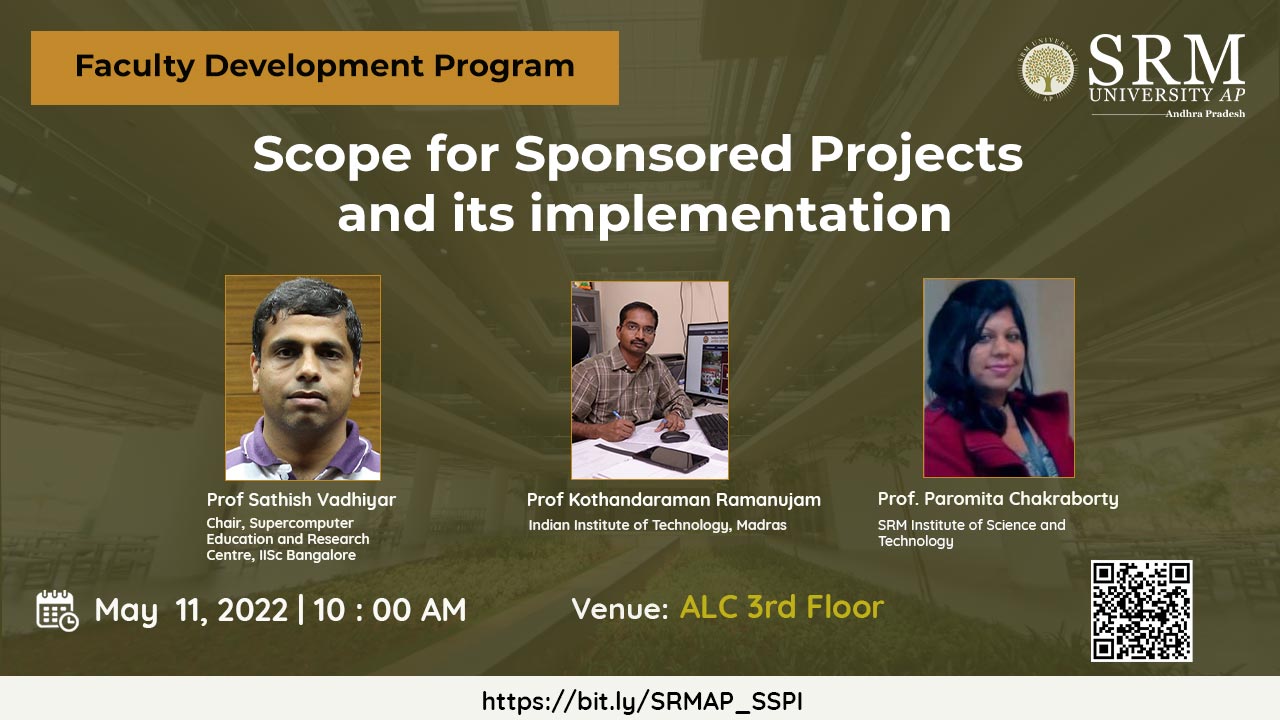
The Department of Physics is organising a Faculty Development Program on ‘Scope for Sponsored Projects and its Implementation’ with eminent academicians, Prof Sathish Vadhiyar, Chair, Supercomputer Education and Research Centre, IISc Bangalore and Prof Kothandaraman Ramanujam, Indian Institute of Technology, Madras.
Date: May 11, 2022
Time: 10.00 am
Venue: ALC 3rd Floor
Discussing the scopes and challenges of such sponsored projects is inevitable as it determines the progress in its execution. Documenting a list of the project goals, deliverables, tasks, costs and deadlines is, therefore, an important part of this process. This will help in establishing the objectives of the project, analysing its limits, and providing a roadmap to move ahead.
Prof Sathish Vadhiyar will deliver a talk on the National Supercomputing Mission (NSM) Program which was introduced by the government of India with an aim to connect national academic and R&D institutions with a grid of high-performance computing facilities. This is an effort to improve the number of supercomputers owned by India. Prof Kothandaraman Ramanujam will provide a brief awareness regarding consultancy projects set up with the industry through his talk. The session will be wrapped up by Prof Paromita Chakraborty who will give an overview of funded projects and bilateral projects.
Join here for an informative session.
Continue reading → - USA Mega Admission Drive; Climb the career ladder with SRM AP May 10, 2022
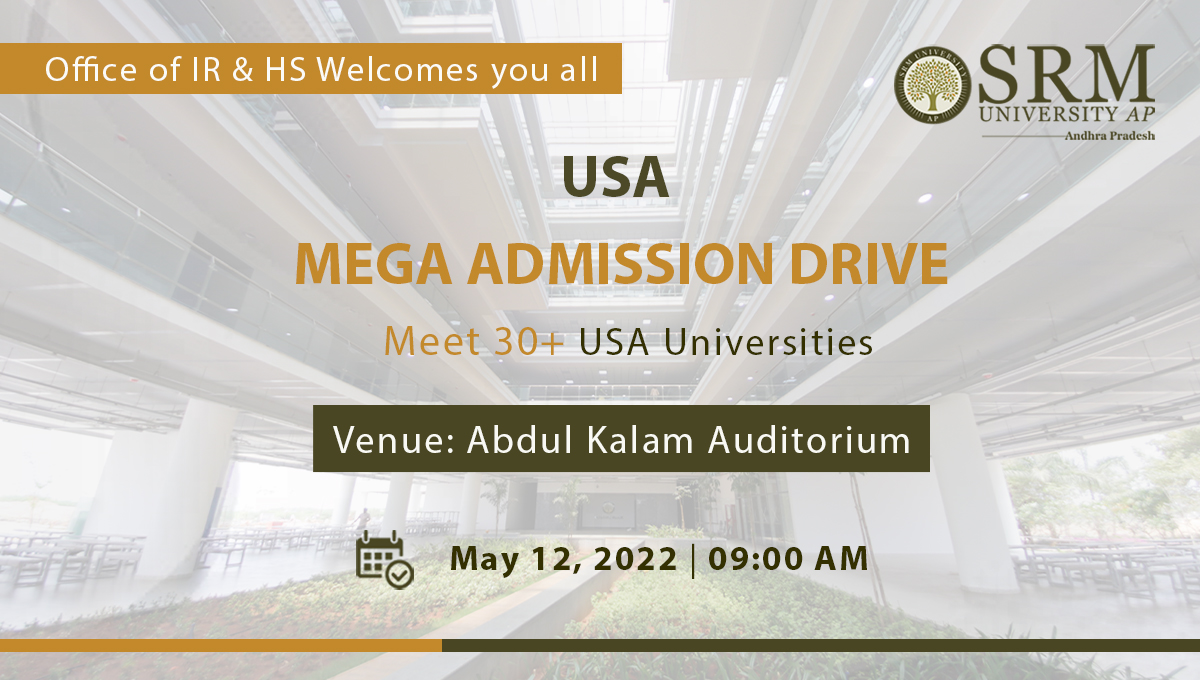 At times, face-to-face interaction will help you find specific answers to your specific questions there and then. This is super important when sorting out decisions about your higher education. SRM AP would like to navigate your road to the master’s admission you have always dreamt of. We urge you to open the door to global opportunities and confidently climb the career ladder.
At times, face-to-face interaction will help you find specific answers to your specific questions there and then. This is super important when sorting out decisions about your higher education. SRM AP would like to navigate your road to the master’s admission you have always dreamt of. We urge you to open the door to global opportunities and confidently climb the career ladder.The Office of International Relations and Higher Studies welcomes you all to the USA Mega Admission Drive, an excellent opportunity to meet more than 30 USA Universities. In a world of information abundance, getting appropriate information is the real challenge. Thus, the university is delighted to offer you one-on-one interaction with the world-class university or institution representatives.
Date: May 12, 2022
Time: 9.00 am to 11.00 am IST
Venue: Abdul Kalam Auditorium
Get to know about the programs, eligibility, scholarships, internships, and post-study work opportunities through a more human element in your university search process. A deeper insight into the variety of options will guide you to apply for 2022/23 intakes. The admission drive allows submitting applications on the spot. The participating universities include renowned global universities such as North-eastern University, University of Massachusetts, Western Washington University, The University of Arizona, University of South Florida, Nova South-eastern University, University of Bridgeport, and many more.
Come and participate.
It’s your turn to explore the best career options awaiting you!
Continue reading → - Igniting the innovative spirit May 10, 2022
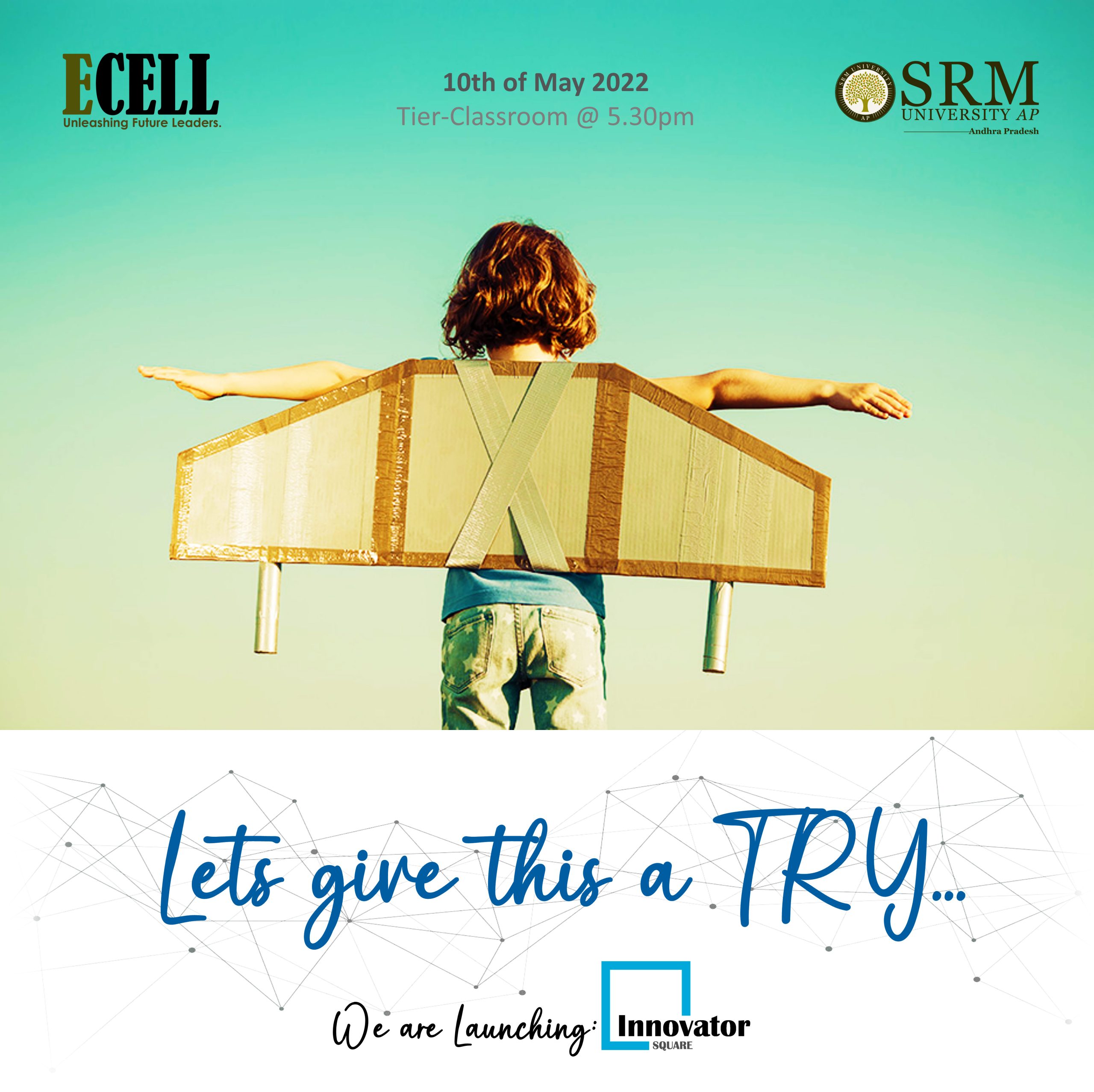
“The only way to discover the limits of the possible is to go beyond them into the impossible”- Arthur C Clarke
The indomitable spirit to give birth to the impossible is the magical force that keeps changing the face of the world. Every innovation, be it in the field of technology, medicine, or entrepreneurship, has paved the way for colossal changes simplifying life on earth. The sheer ability to think and innovate is what made human beings the ruling power. All the amenities and services that we revel in today would not have come into existence without the power to innovate.
As the world is surging ahead with far-reaching developments at an unimaginable pace, there is no question about equipping society to embrace these changes and equally be an unflinching source instigating such changes. Learning in the present era is beyond the ability to read, write and pass with flying colours. True learning does not take place without igniting the spark of creativity hidden inside every individual. The Entrepreneurship Cell has scheduled the launch of their latest endeavour “Innovation Square” to put on show the unrelenting power of innovation of our students.
Date: May 10, 2022
Time: 05.30 pm
Venue: Tiered Classroom
Join the session to behold some of the live innovations of our students at the campus.
- Inspiring the world with quality research facilities May 7, 2022
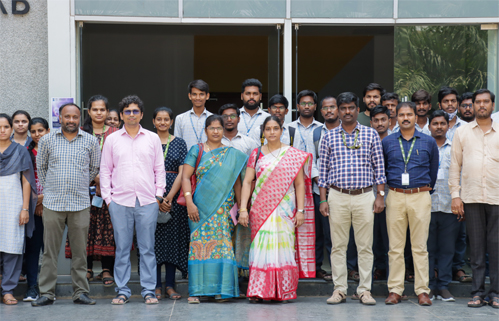 SRM AP is known for its resources and facilities for pioneering research with the support of global leaders and SME’s while sticking to compliance and international regulations. Obtaining research excellence in every field of study has been a mission of the university. Recently, 50 MSc students from the Department of Chemistry, KBN College, Vijayawada, visited our university to explore the analytical and research facilities available here.
SRM AP is known for its resources and facilities for pioneering research with the support of global leaders and SME’s while sticking to compliance and international regulations. Obtaining research excellence in every field of study has been a mission of the university. Recently, 50 MSc students from the Department of Chemistry, KBN College, Vijayawada, visited our university to explore the analytical and research facilities available here. The research areas handled by the Department of Chemistry of SRM AP include the disciplines of chemical sciences, ranging from organic, inorganic, and physical, to theoretical or computational chemistry. The department’s highly disciplinary and collaborative environment is indeed inspiring, and it continues to grab attention. The strong interactions of the university with other premier institutions across India and around the world refine the quality of analytical and research facilities available here. The students from KBN college eagerly interacted with the faculty members and research scholars. Dr Mahesh Kumar Ravva and Dr Rajapandiyan, Faculty members, coordinated the visit.
Continue reading → - Learn the hacks and craft your resume May 6, 2022
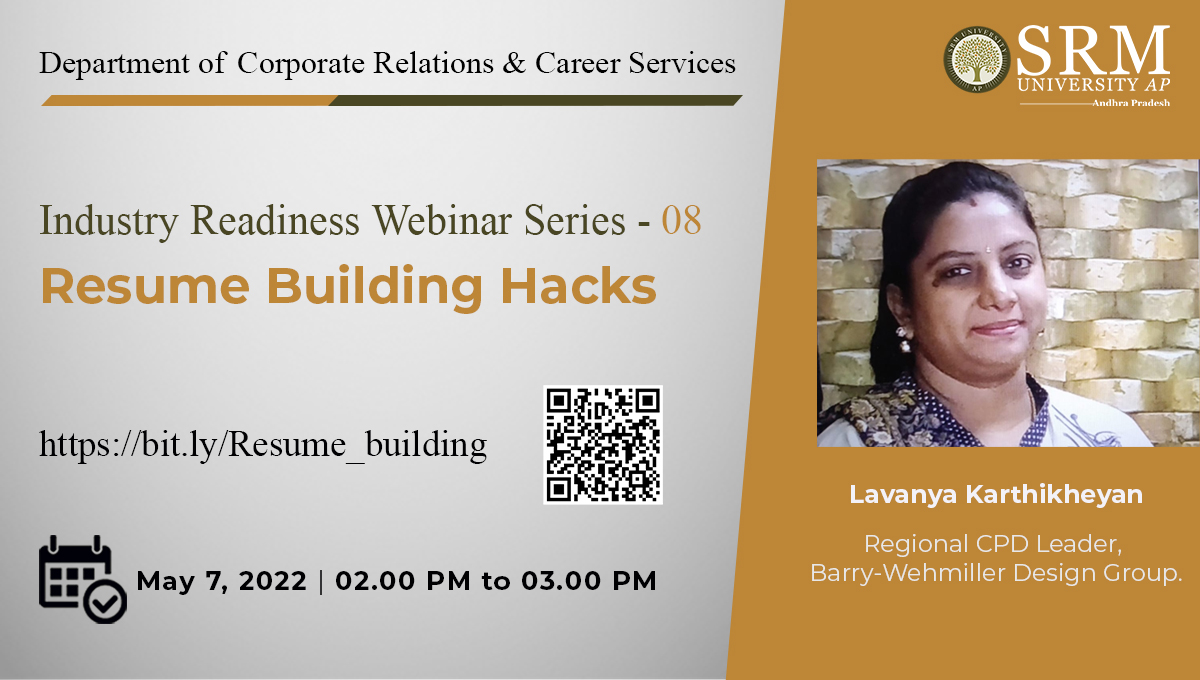 A resume is your gateway to the exciting opportunities ahead. It manages to pave the way for a variety of career options. Building a resume that can highlight your most attractive skills and experiences is the first step in entering a highly competitive job market. Making yourself visible in a pool of aspirants is the key to grab your chance. A resume is not a mere document but a tool for marketing yourself. Thus, crafting a resume deserves your time and attention.
A resume is your gateway to the exciting opportunities ahead. It manages to pave the way for a variety of career options. Building a resume that can highlight your most attractive skills and experiences is the first step in entering a highly competitive job market. Making yourself visible in a pool of aspirants is the key to grab your chance. A resume is not a mere document but a tool for marketing yourself. Thus, crafting a resume deserves your time and attention.The Department of Corporate Relations & Career Services is organising the 8th segment of the industry readiness webinar series. The distinguished guest, Ms Lavanya Karthikheyan, Regional CPD Leader, Barry-Wehmiller Design Group, will deliver a speech on Resume building hacks.
Date: April 7, 2022
Time: 2.00 pm to 3.00 pm IST
Join the webinar and learn some critical hacks to build an excellent resume.
Continue reading → - The network of mindfulness, leadership, and performing arts May 6, 2022
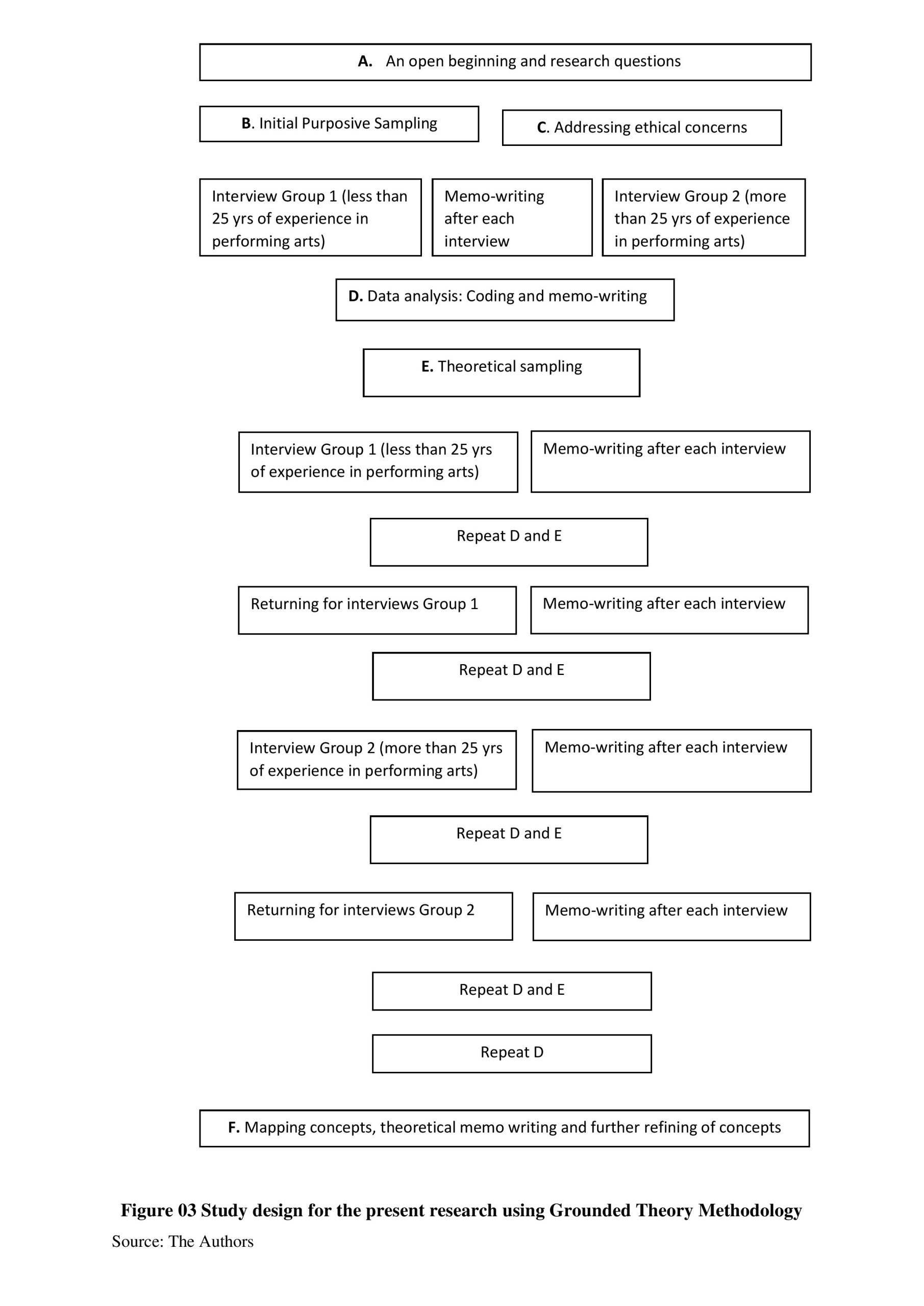 Mindfulness, leadership, and performing arts have deep interconnections that, if approached theoretically, can give productive outcomes to implement in workplaces and potential employees. The School of Entrepreneurship and Management Studies is delighted to inform you that the paper titled ‘Exploring mindfulness and leadership development: Lessons learned using grounded theory through the study of the performing arts’ by Dr Vimal Babu, Associate Professor, got published in the journal FIIB Business Review published by SAGE publication.
Mindfulness, leadership, and performing arts have deep interconnections that, if approached theoretically, can give productive outcomes to implement in workplaces and potential employees. The School of Entrepreneurship and Management Studies is delighted to inform you that the paper titled ‘Exploring mindfulness and leadership development: Lessons learned using grounded theory through the study of the performing arts’ by Dr Vimal Babu, Associate Professor, got published in the journal FIIB Business Review published by SAGE publication.Abstract of the research
The research looks at mindfulness mechanisms and leadership characteristics as they are expressed in performing art forms. This qualitative study examines major categories to create a theoretical framework for mindful leadership development using performing arts. The present study employs the research paradigm of interpretivism to investigate respondents’ experiences and unique phenomena. The Grounded theory (GT) methodology helps explore grounded data and the development of theories. The abstract core category ‘Immense Concentration and Self-Control’ captures the abstract and inclusive meaning as understood by the sample respondents. The qualitative coding analysis aided in the investigation of the data-driven abstract phenomena. According to the findings of this study, all performing artists require a higher level of attention and self-control to demonstrate fascinating performances like Koodiyattam. A higher level of attention and self-control can be ensured based on increased mindfulness, identified leadership attributes, motivation components, values and beliefs, and personality dispositions of the performing artists. In-depth theoretical reflections on the relationships between the relevant categories are presented. The relationships between the five major categories of mindfulness processes, leadership abilities, motivation components, values and beliefs, and personality dispositions are very significant.
Explanation of the research
In simple terms, the present research explores the dynamics of mindfulness, leadership, and other potential variables enabling mindful leadership through performing arts, helping the practicing managers learn the innovative approaches to inculcate mindful leadership in employees in the workplace. To attain the research purpose, researchers studied the Koodiyattam performing arts as an instrument of mindfulness and leadership based on in-depth interviews of Koodiyattam performing artists. Since the present work explores deeper meanings and experiences to unearth unique and insightful phenomena, the Grounded Theory was appropriately employed as a methodology.
Practical implementation of the research
Managers and executives can derive valuable insights based on the present study. They would be able to understand the interconnections of mindfulness, leadership, and performing arts. It would offer them a better grounding to argue and introduce arts-based initiatives at their workplaces to enhance mindful leadership amongst potential employees aiming for well-being and career development in the organization. Several organizations have been experimenting with arts and its impact on business. However, the studies are in the nascent stage. Hence, more like-minded researchers need to join hands for diverse, global, and intercultural studies, focusing on different variables, including arts. The findings of the present research exhibit firm conviction in enlightening the industry practitioners to consider performing arts based mindful leadership training to enhance mindfulness and leadership attributes of the employees, in turn, making them productive and engaged workforce in the long run.
For this research, Dr Vimal babu has collaborated with Dr Amresh Kumar, IIM, Bodh Gaya, India, and Vipin Kumar, PMP, BT India, Gurgaon, India. His future research plans are to work in strategic leadership, negotiation, and conflict management using innovative qualitative research methods. Entrepreneurship education and circular entrepreneurship are also an area of much interest.
Continue reading → - SRM AP Team Meets ARCI: Mutual Discussions on Research Projects May 6, 2022
Continue reading →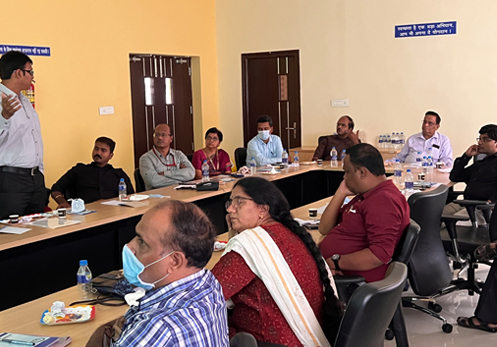 The SRM University-AP team met Dr. Tata Narasinga Rao, Director, International Advanced Research Centre for Powder Metallurgy and New Materials (ARCI, Hyderabad) on 7 April 2022, Thursday. ARCI is an internationally acknowledged autonomous body under the Department of Science and Technology (DST), Government of India. Ten professors, led by SRM University Pro-Vice-Chancellor, Prof. D Narayana Rao, went to Hyderabad to meet the ARCI Director. Projects related to key advanced materials in the field of scientific research were discussed during the meeting. Discussions were held on research projects related to additive (3D) manufacturing, solar energy materials, automotive energy and nanomaterials. The SRM AP Professors; Prof. D Narayana Rao, Prof. G S Vinod Kumar and Prof. Ranjit Thapa explained the key points of the research to the ARCI Director. During the event, an understanding was reached on issues such as research partnership between the two organisations and the design of research facilities. Director Dr. Tata Narasinga Rao assured that ARCI would extend full cooperation in areas such as research assistance in the selected fields and provide other facilities. Prof. Narayana Rao affirmed that ARCI has agreed to provide necessary funds for the development of solid electrolytes used to manufacture Lithium Ion batteries.
The SRM University-AP team met Dr. Tata Narasinga Rao, Director, International Advanced Research Centre for Powder Metallurgy and New Materials (ARCI, Hyderabad) on 7 April 2022, Thursday. ARCI is an internationally acknowledged autonomous body under the Department of Science and Technology (DST), Government of India. Ten professors, led by SRM University Pro-Vice-Chancellor, Prof. D Narayana Rao, went to Hyderabad to meet the ARCI Director. Projects related to key advanced materials in the field of scientific research were discussed during the meeting. Discussions were held on research projects related to additive (3D) manufacturing, solar energy materials, automotive energy and nanomaterials. The SRM AP Professors; Prof. D Narayana Rao, Prof. G S Vinod Kumar and Prof. Ranjit Thapa explained the key points of the research to the ARCI Director. During the event, an understanding was reached on issues such as research partnership between the two organisations and the design of research facilities. Director Dr. Tata Narasinga Rao assured that ARCI would extend full cooperation in areas such as research assistance in the selected fields and provide other facilities. Prof. Narayana Rao affirmed that ARCI has agreed to provide necessary funds for the development of solid electrolytes used to manufacture Lithium Ion batteries. - Engineering and research challenges in building smart cameras May 6, 2022
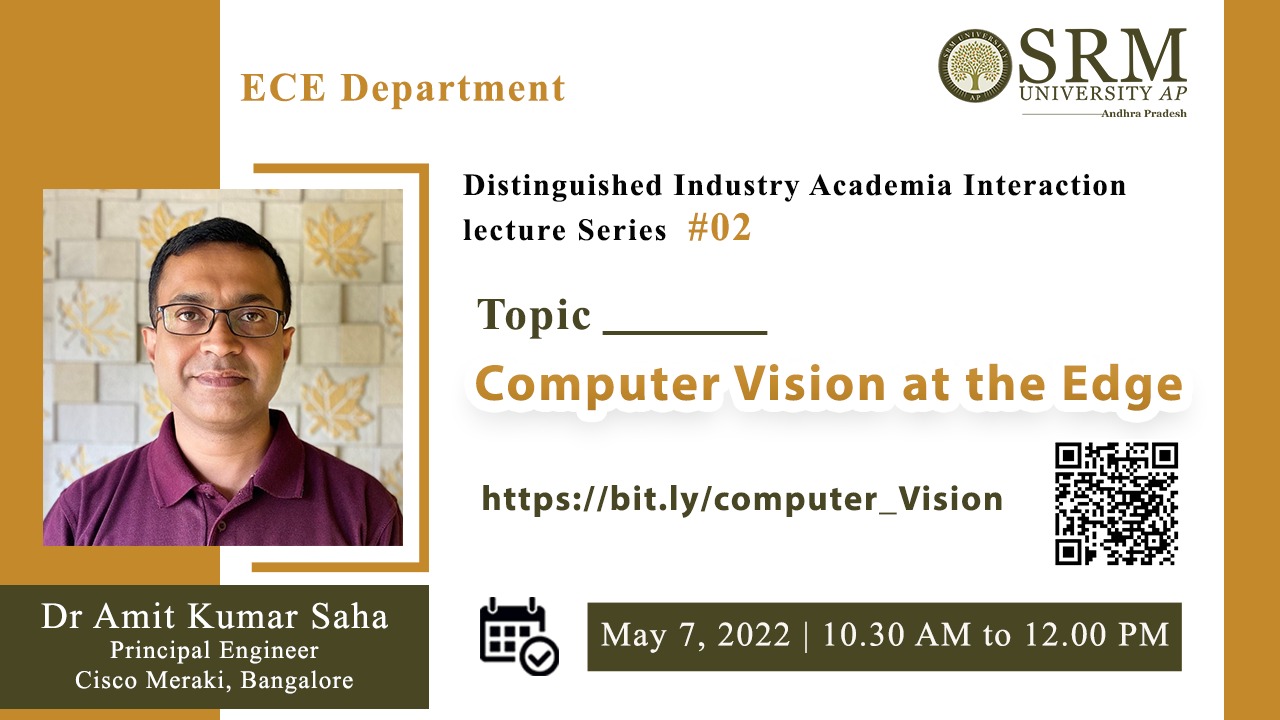 Machine Learning has started its move from the cloud to the periphery of the network. Today’s edge devices are becoming smarter and are no longer the dumb devices that would simply transmit the data to some central location. The Department of Electronics and Communication Engineering is conducting the 2nd department distinguished Industry-Academia Interaction lecture in the ECE DDIAIL series. Dr Amit Kumar Saha, Principal Engineer at Cisco Meraki, Bangalore, will deliver a talk on the topic ‘Computer vision at the edge’.
Machine Learning has started its move from the cloud to the periphery of the network. Today’s edge devices are becoming smarter and are no longer the dumb devices that would simply transmit the data to some central location. The Department of Electronics and Communication Engineering is conducting the 2nd department distinguished Industry-Academia Interaction lecture in the ECE DDIAIL series. Dr Amit Kumar Saha, Principal Engineer at Cisco Meraki, Bangalore, will deliver a talk on the topic ‘Computer vision at the edge’.The talk will focus on the evolution of a specific type of edge device, the surveillance camera, from the traditional CCTV model to the smart camera model. It will discuss some of the engineering and research challenges in building smart cameras that lie at the periphery of the network.
Date: May 7, 2022
Time: 10.30 am to 12.00 pm IST
About the speaker
Dr Amit Kumar Saha is the Principal Engineer at Cisco Meraki, Bangalore. He received his PhD degree from Rice University in 2007. Prior to that, he obtained his BTech degree from IIT Kharagpur as a recipient of Dr B C Roy Gold Medal in 1999 for being the single graduating student with the best mix of academics and extracurricular activities. Dr Amit explores the next generation of technology at the intersection of networks, distributed systems, and data science, with a special emphasis on system-wide design. He is part of Cisco Meraki’s Camera Intelligence team and enables Cisco’s internal products as well as customers better manage their AI/ML life cycles by making it easier to train and tune models and deploy distributed machine learning workloads. He passionately seeks out opportunities to give back to the community through talks, research collaborations, organising conferences, and as visiting faculty at several top institutes in India.
Join the webinar and learn from industry professionals


